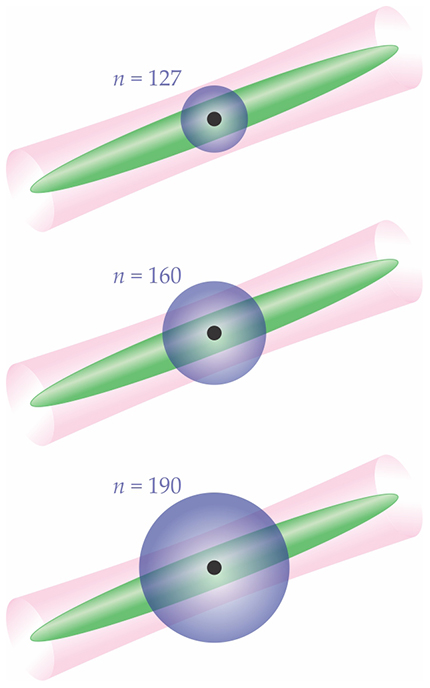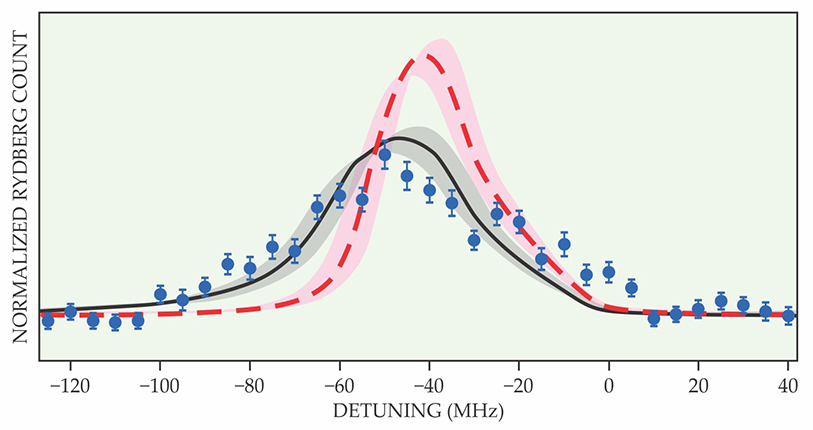A Bose–Einstein condensate in an atom
DOI: 10.1063/PT.3.3964
Impurity-induced scattering is at the heart of some of the most intriguing phenomena in condensed-matter physics, including the Anderson localization of electrons in impurity- and defect-laden lattices (see the article by Ad Lagendijk, Bart van Tiggelen, and Diederik Wiersma, Physics Today, August 2009, page 24
A long-standing goal has been to implant a charge impurity—an ion—in a Bose–Einstein condensate (BEC) of neutral atoms, where ion–atom scattering is expected to give rise to exotic bound states and unusual charge-transport dynamics. That goal has proven elusive, largely due to ions’ sensitivity to stray electric fields. Those fields prevent ions from sitting still in the optical traps commonly used to capture and cool neutral atoms to the ultracold regime. Experimenters have flirted with hybrid setups, in which the ion is held in an RF trap and then merged with an optically trapped BEC. But the oscillating RF field inevitably jiggles the ion. That jiggling can warm the condensate to millikelvin temperatures, well above the 100 nK or so required for quantum scattering. 1 Even in the rare case where an ion has been captured in an optical trap, merging the ion with a BEC remains difficult. 2
Now researchers led by Florian Meinert and Tilman Pfau of the University of Stuttgart in Germany have devised a cooler way to embed an ion in a BEC. 3 The trick is that the ion technically isn’t an ion at all; it’s a neutral atom—a Rydberg atom—masquerading as one.
Atomic giants
A Rydberg atom is one in which the outermost electron roams far from the nucleus in a highly excited, loosely bound orbit. Pfau’s group has spent years perfecting techniques for creating them. These days the researchers routinely create giant Rydberg atoms with principal quantum number n approaching 200. That corresponds to an orbital radius of several micrometers, roughly 10 000 times larger than normal.
A few years ago, Pfau and Meinert, a postdoc, had the idea to deploy Rydberg atoms as impurities in BECs. They figured that, with a suitable optical pulse, they could excite one of the condensate’s atoms to a Rydberg state. The newly minted Rydberg atom would interact with its neighbors as if it were two distinct entities: a negatively charged electron and a positively charged ionic core.
The group’s calculations showed that if the electron orbits at a distance similar to the characteristic spacing between atoms in the BEC, neighboring atoms interact primarily with the electron. But if the orbit can be made much larger, the electron’s influence wanes and the neighbors effectively see only the ionic core. Meanwhile, the loosely bound electron effectively acts as a Faraday cage that shields the ionic core from stray electric fields.
Despite their best efforts, the researchers couldn’t make the Rydberg atoms big enough to reach the ion–atom interaction regime, and their idea nearly shriveled on the vine. Eventually, however, they realized that instead of making the Rydberg atoms bigger, they could make the BECs smaller.
“There were groups using tightly focused optical tweezers to trap tiny, dense BEC clouds,” Meinert recalls. He and his coworkers incorporated such a trap into their own experimental setup and found that they could create cigar-shaped BECs of rubidium-87 whose cross section fit entirely inside the micrometer-sized orbit of a Rydberg atom, as illustrated in figure
Figure 1.

An ion imposter. In an experiment designed to mimic the behavior of an ion impurity in a cold neutral-atom bath, a single atom of a Bose–Einstein condensate (green) trapped in an optical beam (pink) is excited to a Rydberg state. If the Rydberg atom’s principal quantum number n is sufficiently large, the size of its outer electron orbital (purple) can far exceed the width of the condensate. In that limit, the core of the Rydberg atom can essentially be treated as a positive ion. (Adapted from ref.

“This was really an outside-the-box approach,” comments Dietrich Leibfried, an experimentalist at NIST. “In a field dominated by ion trappers who dabble with neutral atoms and neutral-atom trappers who dabble with ions, the Stuttgart group came in with an entirely neutral experiment.”
Although the Stuttgart group has yet to obtain measurements of collision cross sections and many other properties of interest, spectral data contain strong clues of the ion–atom nature of the Rydberg–BEC interaction. Figure
Figure 2.

An ionic signature. Spectral data show the likelihood of a Rydberg transition—to a state with quantum number n equal to 160—in a Bose–Einstein condensate (BEC) of rubidium-87 as a function of the detuning of the excitation beam. The observed redshift and line broadening can’t be fully explained by treating the Rydberg atom as an electron (red). A model (black) that treats BEC–Rydberg interactions as atom–ion interactions yields a better fit. The shaded areas indicate 10% uncertainty. (Adapted from ref.

Toward quantum collisions
At the outset of the Stuttgart group’s experiment, before the Rydberg atom is introduced, the temperature of the BEC is just 250 nK. The researchers estimate that the temperature remains below a microkelvin throughout the experiment. That’s cold, but still not quantum-scattering cold.
The starting temperature of the BEC isn’t a major concern; there are plenty of ways to coax a condensate of neutral atoms deep into the ultracold regime. More worrisome is the recoil energy the Rydberg atom absorbs during its two-photon transition to the excited state. That energy alone is enough to warm the atom and its surroundings by a few hundred nanokelvin. Meinert thinks the recoil problem can be overcome with more sophisticated excitation schemes. For instance, with counterpropagating excitation beams, the momenta of the absorbed photons could cancel.
Assuming the researchers reach the ultracold regime, there remains the question of how much they’ll see. Currently their Rydberg atom survives for only a couple of microseconds before it collides with a neighbor, absorbs a jolt of kinetic energy, and gets kicked out of the trap. That lifetime is too brief to shed light on most dynamical processes of interest.
The key to extending the atom’s life might be to prepare it in a circular Rydberg state—one with a large orbital angular momentum quantum number. The atom ejections appear to result from a particular kind of collision that occurs when the excited electron and a neighboring atom from the BEC are simultaneously in the vicinity of the Rydberg atom’s ionic core. The probability of such a three-body encounter plummets with circular Rydberg atoms, in which the outermost electron seldom ventures near the core.
A circular Rydberg atom could potentially survive for several milliseconds, though Meinert notes that preparing the fragile atoms in a manner that preserves a BEC’s ultracold temperatures wouldn’t be trivial. “We still have to do the calculations to see exactly how a circular orbit would behave in the trapping field and how effective its stray-field shielding would be,” he says. “But I think it could work.”
References
1. C. Zipkes et al., Nature 464, 388 (2010). https://doi.org/10.1038/nature08865
2. T. Huber et al., Nat. Commun. 5, 5587 (2014); https://doi.org/10.1038/ncomms6587
A. Lambrecht et al., Nat. Photonics 11, 704 (2017). https://doi.org/10.1038/s41566-017-0030-23. K. S. Kleinbach et al., Phys. Rev. Lett. 120, 193401 (2018). https://doi.org/10.1103/PhysRevLett.120.193401
